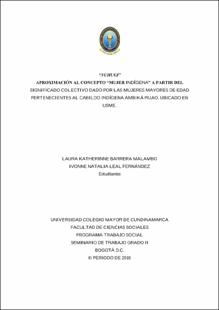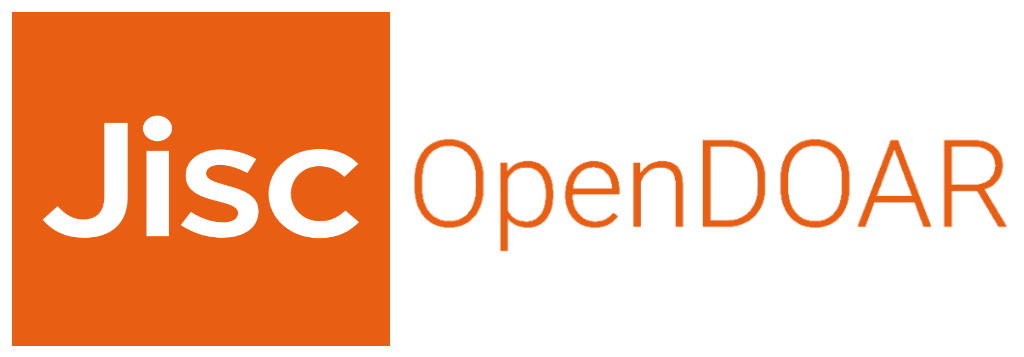Aproximación al concepto “mujer indígena” a partir del significado colectivo dado por las mujeres mayores de edad pertenecientes al cabildo indígena Ambiká Pijao, ubicado en Usme
Trabajo de grado - Pregrado
2018
Universidad Colegio Mayor de Cundinamarca
La presente investigación pretende identificar el concepto “mujer indígena” dado por
las mujeres pertenecientes al cabildo indígena Ambiká Pijao, por medio del análisis del
discurso propio de las mismas, reconociendo el contexto rural del cual son provenientes y el
contexto urbano en el que se encuentran actualmente y dando importancia a las
transformaciones culturales de sus identidades.
Esta es desarrollada a partir del método cualitativo, respaldada por el paradigma
interpretativo y la metodología del análisis del discurso, propuesta por Helena Calsamiglia
Blancafort y Amparo Tusón Valls en su libro "Las cosas del decir. Manual de análisis del
discurso”, el cual establece que el proceso se lleva a cabo a partir de la definición nominal, la
inducción de las categorías y la recolección de los datos, esto por medio de una serie de
técnicas que posteriormente permitiera el análisis de los datos, con el fin de obtener la
información necesaria se realizaron entrevistas semiestructuradas con guía, a cuatro (4)
mujeres médicas ancestrales y un grupo focal con guía, conformado en su gran mayoría, por
las mujeres mayores de edad pertenecientes al consejo de jóvenes y mujeres del cabildo
Ambiká Pijao.
Consiguiente a los aportes recogidos se da referencia para la realización de nuevas
investigaciones que estén dirigidas al reconocimiento de las identidades y las
transformaciones culturales en diferentes poblaciones étnicas a lo largo de todo el territorio
colombiano, buscando de esta manera evidenciar lo que conlleva el ser indígena y desde
luego mujer indígena. The purpose of the present research is to identify the concept of "Indigenous woman"
given by the women belonging to the indigenous town hall called Ambiká Pijao, through
their speech analyses , recognizing the rural context which they came from and the urban
context in which they are involving now, giving importance to the cultural transformation of
their identities.
This research is developed with the qualitative method, and it is supported with the
interpretative paradigm and the discourse analyses proposed by Helena
CalsamigliaBlancafort and Amparo Tusón Valls in their book "Las cosas del decir. Manual
de análisis del discurso”. In which, it is established the process that might be done from the
nominal definition, induction of the categories and data collection, the previous over
different techniques that later on, will let the data analyses.
In order to obtain the necessary information, structured interviews were made to 3
older women (ancestral medical women) and a focus group, formed by older women
belonging to the council of the town hall called AmbikáPijao.
As a result of the collected contributions, it is given the reference to the realization of new
researches referring to the recognition of the identities and the transformations given in the
ethnic populations.
- ACD. Trabajo Social [1526]
Descripción:
Nuhugi. Ambiká Pijao - Versión final.pdf
Título: Nuhugi. Ambiká Pijao - Versión final.pdf
Tamaño: 1.444Mb
 PDF
PDF
 LEER EN FLIP
LEER EN FLIP
Descripción: Nuhugi. Ambiká Pijao - Versión final FORMATO CARTAS.pdf
Título: Nuhugi. Ambiká Pijao - Versión final FORMATO CARTAS.pdf
Tamaño: 544.4Kb
 PDF
PDF
Título: Nuhugi. Ambiká Pijao - Versión final.pdf
Tamaño: 1.444Mb
 PDF
PDF
 LEER EN FLIP
LEER EN FLIP
Descripción: Nuhugi. Ambiká Pijao - Versión final FORMATO CARTAS.pdf
Título: Nuhugi. Ambiká Pijao - Versión final FORMATO CARTAS.pdf
Tamaño: 544.4Kb
 PDF
PDF























